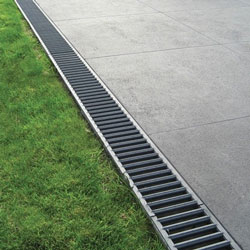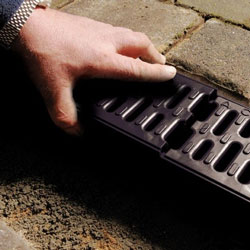Channel drains are a common construction item used around the world for a variety of purposes. You may also hear them called trench drains or linear drains. But how does channel drainage work?
The simplest explanation of how drainage channels work is based on gravity. Accordingly, channel drains should always be positioned at a point where surface water is likely to roll towards (i.e. not uphill!).
 Linear drainage systems drain water along their entire length, rather than at one point as a gully does. They are made up of an enclosed channel with some form of grating over the top.
Linear drainage systems drain water along their entire length, rather than at one point as a gully does. They are made up of an enclosed channel with some form of grating over the top.
The main purpose of a channel drain is to remove surface water away from a selected area. This helps to prevent flooding and overspilling. These drains are also used to control water flow in an area by reducing the stress being put on the system. So selecting the right flood defence product is key to flood prevention.
Types and applications of channel drainage
There are two basic types of channel drains; those with built-in falls, and those that maintain a regular depth along their entire length. Those with built-in falls tend to be used to drain large, flat areas such as car parks. The ‘regular depth’ type is used for short lengths of drain, and on areas with a natural slope or fall.
Here at Drainage Superstore, we have a wide range of channel drainage solutions available. These range from basic half-metre or metre-long concrete units for use on private driveways, to stainless steel units with medical uses.
Channel drains come in a variety of sizes, from 50mm units for roof drainage to 250mm deep motorway drains. They are designed using a variety of materials, including polymer concrete, wet-press concrete, HDPE and stainless steel. The end use of the drain will determine which type is most suitable (read up on how to select the right channel drain before your purchase).
 There are also a number of accessories that will be required for certain projects. We supply a wide range including sump units, access and corner units, end caps, and outlet adaptors for channel drains.
There are also a number of accessories that will be required for certain projects. We supply a wide range including sump units, access and corner units, end caps, and outlet adaptors for channel drains.
You may also need to consider how to choose guttering materials and find out more about additional drainage solutions.
For answers to questions such as what is a soil and waste system?, what is rainwater harvesting?’ and what is the function of a non-return valve?, check out our website or contact us directly.
Don’t hesitate to visit our how to guides to find a guide on how to install an ACO drain and understand a common query; ‘how does a drain rod work?’.














